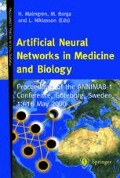Abstract
In this paper we argue that the explicit account of uncertainty in data modeling is particularly important for biomedical applications of neural networks and related techniques. There are several sources of uncertainty of a model, including noise, bias and variance. Unless one attempts to identify or minimize the sources that contribute to errors of a particular application, one only has a sub-optimal solution. If, on the other hand, one does attempt to model uncertainty, one gets several major advantages. We discuss several methods for modeling uncertainty, including density estimation, Bayesian inference and complex noise models, in the context of several sample applications — most notably in the domain of biosignal processing.
Access this chapter
Tax calculation will be finalised at checkout
Purchases are for personal use only
Preview
Unable to display preview. Download preview PDF.
References
Bell AJ, Sejnowski TJ. An information maximisation approach to blind separation and blind deconvolution. Neural Computation 1995; 7:1129–1159
Oja E. From neural learning to independent components. Neurocomputing 1998; 22:187–200
Penny WD, Roberts SJ. Hidden Markov Models with Extended Observation Densities, Imperial College, Neural Systems Research Group, Technical Report TR-98-15, 1998
Vapnik V. The Nature of Statistical Learning Theory. Springer-Verlag, New York, 1995
Bishop CM. Neural Networks for Pattern Recognition. Clarendon Press, Oxford, 1995
Penny WD, Roberts SJ. Neural network predictions with error bars. Imperial College, Neural Systems Research Group, Research Report TR-97-1, 1997
Hasan J. Automatic analysis of sleep recordings: a critical review. Annals-Clin-Res. 1985; 17:280–287
Breiman L. Bias, variance, and arcing classifiers., Statistics Department, University of California, Berkeley, CA, USA, Tech. Rep. 460, 1996
Bishop CM. Mixture Density Networks, Department of Computer Science and Applied Mathematics, Aston University, Birmingham, UK, NCRG/94/004, 1994
Neal RM. Bayesian Learning for Neural Networks. Springer, Berlin/Heidelberg/New York/Tokyo, 1996
MacKay DJC. Bayesian Methods for Adaptive Models. California Institute of Technology, Pasadena, CA, 1992
Dorffner G, Leitgeb E, Koller H. A comparison of linear and non-linear classifiers for the detection of coronary artery disease in stress-ECG, in Horn W. et al.(eds.), Artificial Intelligence in Medicine, Springer, Berlin, LNAI 1620, 1999, pp.227–231
Flexer A. Statistical Evaluation of Neural Network Experiments: Minimum Requirements and Current Practice. in Trappl R. (ed.): Cybernetics and Systems’ 96, Oesterreichische Studiengesellschaft fuer Kybernetik, Wien, 2 vols, 1996., pp. 1005–1008
Rezek IA, Roberts SJ. Stochastic Complexity Measures for Physiological Signal Analysis. IEEE Transactions on Biomedical Engineering 1998; 44:1186–1191
Sykacek P, Dorffner G, Rappelsberger P, Zeitlhofer J. Experiences with bayesian learning in a real world application. In Jordan M.I., et al.: Advances in Neural Information Processing Systems 10, MIT Press/Bradford Books, Cambridge/London, 1998, pp.964–970
Flexer A, Sykacek P, Rezek IA, Dorffner G. Using Hidden Markov Models to build an automatic, continuous and probabilistic sleep stager for the SIESTA project (extended abstract), Medical and Biological Engineering and Computing 1999; Supplement 2, Proceedings of EMBEC’99, p.1658–1659
Sykacek P, Roberts SJ, Rezek IA, Flexer A, Dorffner G. Reliability in preprocessing — Bayes rules SIESTA (extended abstract), Medical & Biological Engineering & Computing 1999; suppl. EMBEC’99
Author information
Authors and Affiliations
Editor information
Editors and Affiliations
Rights and permissions
Copyright information
© 2000 Springer-Verlag London
About this paper
Cite this paper
Dorffner, G., Sykacek, P., Schittenkopf, C. (2000). Modelling Uncertainty in Biomedical Applications of Neural Networks. In: Malmgren, H., Borga, M., Niklasson, L. (eds) Artificial Neural Networks in Medicine and Biology. Perspectives in Neural Computing. Springer, London. https://doi.org/10.1007/978-1-4471-0513-8_3
Download citation
DOI: https://doi.org/10.1007/978-1-4471-0513-8_3
Publisher Name: Springer, London
Print ISBN: 978-1-85233-289-1
Online ISBN: 978-1-4471-0513-8
eBook Packages: Springer Book Archive

